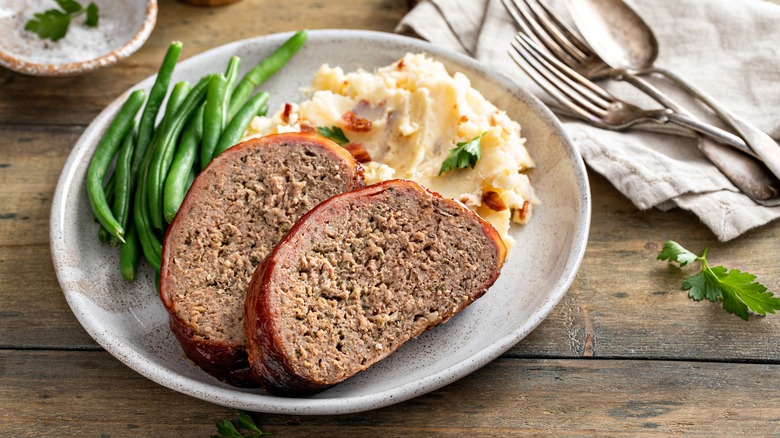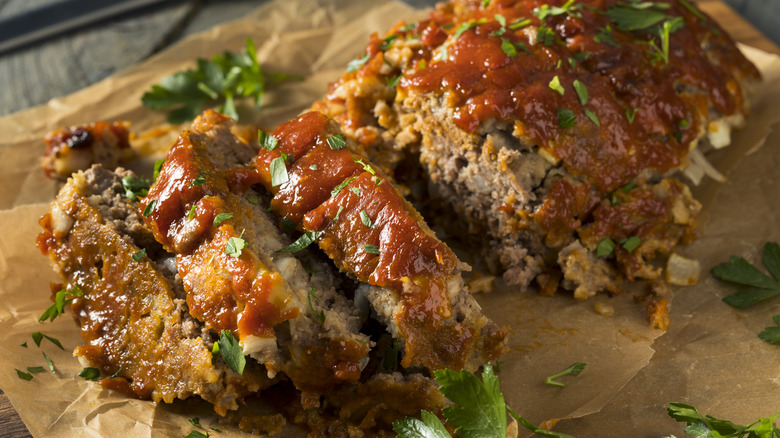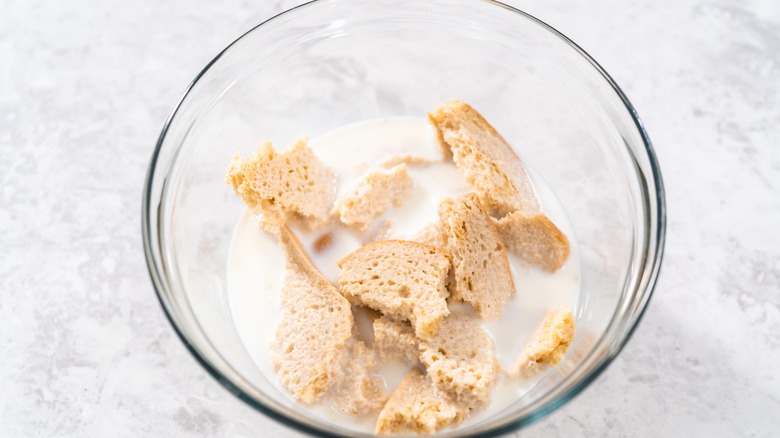The Last-Minute Mistake That Causes Overly Dry Meatloaf
As nostalgic and comforting as the American classic known as meatloaf is, it's still somewhat under-appreciated and often a culinary punchline. Many people of a certain generation remember their childhood meatloaf as dry, flavorless, and full of more fillers like oatmeal and bread than actual meat. But thanks to a renaissance of sorts, flavorful, moist meatloaf is back on many menus at home and at restaurants.
Between the right blend of ingredients and better access to meat than in the Great Depression years when the dish was a great way to stretch a minimal amount of protein, today's meatloaf can be scrumptious. However, you can make the best version on the planet and still ruin it by making one crucial mistake right before you serve it — that is, slicing it too early.
As tempting as it is to slice into your meatloaf when it's fresh from the oven, doing so will drain the dish of moisture and flavor. Just like a steak right off the grill, the meat juices need time to settle and, if they don't, they'll end up running out all over your cutting board, leaving you with a dry, sad loaf. And, at this point, there's really nothing you can do to add moisture back in other than drowning your slice in ketchup.
What happens to the juice when you let meat rest?
Whether you've cooked up a pork roast, ribeye, Thanksgiving turkey, or meatloaf, you're going to have a lot of natural juices just waiting for their opportunity to escape. That's because, when meat is cooked, the muscle fibers release the moisture within, pushing it out towards the surface. It's the reason why your steak drips when it's on the grill (some of this is melted fat, too) and your chicken releases juice into the roasting pan. This liquid, which contains tons of flavor, will eventually redistribute back into the meat once the fibers start to cool down, but it takes some time.
When it comes to meatloaf, just because you've taken other measures to ensure it stays moist, don't assume this will cancel out the need to let it rest. Even if you wrap it up in phyllo dough (the secret that will change your meatloaf forever), the meat will still release precious juices that you'll want to contain. Instead, let it rest for about 10 minutes before you slice into it; don't worry, the dish will still be plenty hot.
Other ways to prevent dry meatloaf
Now that you know what not to do when your meatloaf is done cooking, let's discuss the various ways you can create extra moisture in your old-school throwback dish. Don't overlook the fact that the meat you use matters. In short, you want a grind that has plenty of fat in it, so if you're using ground beef, make sure it has at least 20% fat mixed in. In addition, consider adding some sautéed vegetables to the mix, like onions, leeks, or red peppers, all of which contain a good amount of moisture and will add extra flavor.
Like many people, you may have mixed feelings about adding breadcrumbs to your meatloaf. Sure, they make sense as a filler, stretching the volume of the loaf, but they also absorb moisture. As long as you don't use too much, this is perfectly okay because the crumbs seize onto those warm juices that are otherwise trying to escape the hot dish. Chunks of bread soaked in milk and crushed saltines make good substitutes for breadcrumbs, too. Finally, you can bake the meatloaf over a pan of hot water to keep a steady blanket of moisture over your entrée throughout the cooking process.



